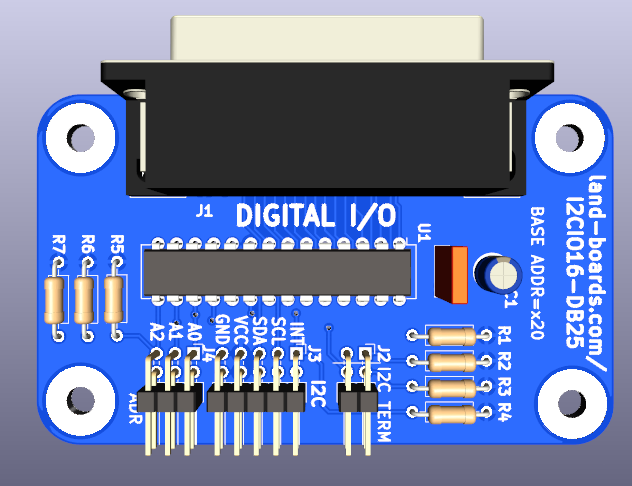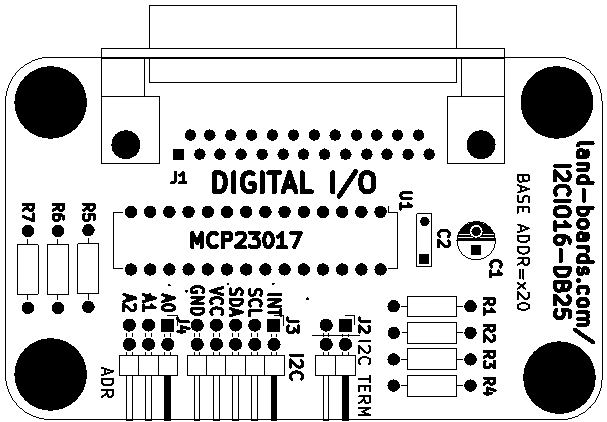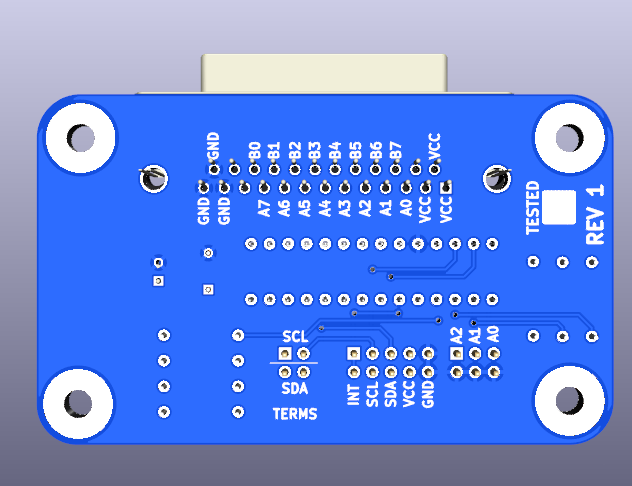Difference between revisions of "I2CIO16-DB25"
Jump to navigation
Jump to search
Blwikiadmin (talk | contribs) |
Blwikiadmin (talk | contribs) |
||
| Line 118: | Line 118: | ||
== Factory Acceptance Tests == | == Factory Acceptance Tests == | ||
| − | [[File:]] | + | [[File:I2CIO16-DB25.PNG]] |
=== Setup === | === Setup === | ||
Revision as of 17:38, 17 June 2022
Contents
16-Bit Digital I/O Card with DB25 Connector
Features
- 16-bit Digital I/O card
- MCP23017 16-bit I2C I/O Expander
- Strong library support for all major microprocessors for MCP23017
- I2C Interface - Two Wire Interface
- Can run at 400 KHz or faster
- I/O Connector is inexpensive/standard DB-25
- Fuse protected power output on DB-25 with jumper bypass
- Large prototyping area
- Connections at edges to DB-25 and GPIO lines
- EEPROM for board ID and application specific information
- Write Enable jumper protects against accidental writes
- Host connectors
- Daisy-chain I2C connector
- Address select jumper
- Expandable I2C via I2C-RPT - I2C Repeater
- I2C Termination jumpers for end of I2C chain
- Power can be 3.3V or 5V
- 95mm wide Open Data Acquisition System format
- 6-32 Mounting holes
Connectors
J1 - DB-25 I/O Connector
- Pins 1, 2, 14 are connected to Ground
- Pins 12, 13, 25 are connected to Power
- Pins 3-11 and 15-24 are connected to the Prototype area and are labeled on the PCB
J2 - I2C Termination
- Two of two position headers
- Install headers in each position to terminate I2C line
- There should only be one I2C termination and it should be at the end of the I2C line
J3 - I2C
- Connector is 2x5 of 0.1" header
- Intended to be used for I2C daisy-chain of 4-pin cabling
- Power can be attached to the connector or power can be provided to the card via the J1 power connector
- May still want to connect ground
- INT
- SCL
- SDA
- VCC
- GND
J4 - Address Select
- Sets the I2C offset address of the card
- Three bit address A1, A2
- A0
- A1
- A2
Rear Side Marking
MCP23017 Drivers
There are quite a I2C drivers for every major microcontroller (Arduino, Raspberry Pi, BeagleBone, etc).
Arduino Drivers
- Land Boards Arduino Driver Code/Example Software for the PROTO16-I2C Card
- Adafruit MCP23017 Arduino Driver
Raspberry Pi Drivers
Raspberry Pi Pico
MMBASIC
- SWLEDX8-01.bas - Read 8x switches, write 8x LEDs
- MMBASIC Example Code - Bounce a bit across the 16-bits (not for use with SWLEDX8 card)
BeagleBone Black Drivers
ESP32 MicroPython Drivers
PyBoard MicroPython Drivers
Linux Drivers
EEPROM
- 24LC024 EEPROM
- 2kbit
- I2C Serial EEPROM
- Wide Voltage range (1.8V to 5.5V)
- 400 KHz operating range
- 10 mS write cycle time
- EEPROM has a board ID
Factory Acceptance Tests
Setup
- Runs ODAS Card Test Software on Arduino Nano NANO-BKOUT with I2C-RPT card
- USB running puTTY
- 9600 baud
Program Personality EEPROM
- Menu driven
- Auto-detects card
- If test has been run before
Checking EEPROM for board type...Detected PROTO16-I2C board R=Read EEPROM, W=Write EEPROM, T=Test DIGIOs, L=Loop Test, B=Bounce LEDs
- Presents card type list for un-programmed EEPROMs
Checking EEPROM for board type...Company Mismatch Select the board type 1 - DIGIO16-I2C board 2 - DIGIO-128 board 3 - OptoIn8-I2C board 4 - OptoOut8-I2C board 5 - DIGIO32-I2C board 6 - PROTO16-I2C board 7 - ODAS-PSOC5 board 8 - TBD board 9 - TBD board Select board >
- Select board
Select board > 6 Writing EEPROM Initializing eep buffer len of buffer=96 reading block Family=ODAS Company=land.boards.com Product=PROTO16-I2C
Run I2C Loopback Tests
- Test 'T'
Loopback Test PASS = 1, FAIL = 0
Run Bouncing LEDs
- Select B
Bouncing LEDs - any key to stop
- Use LED card


